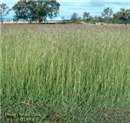Scientific name(s)
Bothriochloa pertusa
Strengths
- Provides a good groundcover.
- Grows on infertile soils.
- Adapted to hard-setting soils.
- Competes well with weeds.
- Produces good quality forage.
- Tolerates heavy grazing.
Limitations
- Awned seed, difficult to harvest, handle and sow.
- Low growing and accumulates small quantity of forage for dry season.
- Becomes unpalatable after flowering.
- Competes strongly with legumes.
- Stand reduced to individual tufts in severe drought exposing land to soil erosion.
Plant description
Plant: A stoloniferous, mat-forming perennial, 30 - 60 cm tall.
Stems: Stolons commonly red or pink, rooting down at nodes. Nodes hairless or hairy. Stems erect, or prostrate becoming erect.
Leaves: Grey-green in colour, the blades 5 - 10 cm long, 2.5 - 5 mm wide. Leaf blade surface is usually hairless except for a few sparse hairs at the base.
Seedhead: Comprise 3 - 8 branches arising from different points on a central axis, 1 - 3 cm long, and purplish in colour.
Seeds: Often pitted, with a sharply bent and twisted awn, 10-18 mm long; 1.0 - 1.5 million seeds/kg.
Pasture type and use
Indian bluegrass is suitable as a permanent pasture on poorer soils. It can be cut for hay. It is used for erosion control, reseeding eroded land, waterways, revegetating mine waste and for lawns, sown by seed or from sprigs.
Where it grows
Rainfall
It is usually sown in areas receiving 600 - 900 mm/yr, but is naturalised in areas outside these limits.
Soils
It is adapted to low fertility, acid to alkaline soils, from sands to clays. It colonises poorer soils when tufted grasses succumb to heavy grazing.
Temperature
It grows during the warm season and tops are killed by heavy frost.
Establishment
Companion species
Grasses: sabi grass, queensland blue couch.
Legumes: roundleaf cassia, jointvetch, lotononis, fine stem stylo, caribbean stylo.
Sowing/planting rates as single species
2 - 3 kg/ha.
Sowing/planting rates in mixtures
1 - 2 kg/ha.
Sowing time
While it can be sown from spring to late summer, it is best sown in spring when annual weeds are minimal, or in mid-summer if spring fallow is required to minimise annual grass and broadleaf weeds before sowing.
Inoculation
Not applicable
Fertiliser
No fertiliser is required for establishment on suitable soils.
Management
Maintenance fertliser
It has a low requirement for plant nutrients for stand persistence, with production usually limited by moisture availability. Suitable soils rarely need additional phosphorus but nitrogen fertiliser increases production, especially on run-down cropping land. Sulphur may be needed on some basalt soils if high rates of nitrogen are applied.
Grazing/cutting
It is suitable for grazing and hay production.
Seed production
Seed can be harvested by header or brush harvester. Seed yields of 100 - 150 kg/ha can be obtained. Fertiliser application of 100 kg N/ha is required for good seed yield.
Ability to spread
It spreads by seed and expands by long stolons that root down at nodes.
Weed potential
It is regarded as a weed of pastures in some areas, although this is usually a symptom of declining fertility and heavy grazing.
Major pests
No major pests known.
Major diseases
Rust and ergot are observed in some varieties or naturalised ecotypes but cause only minor problems in grazed swards or in seed crops.
Herbicide susceptibility
It is killed by glyphosate and is tolerant of atrazine.
Animal production
Feeding value
Quality declines with increasing maturity, especially after flowering. Crude protein levels in young leaf may be 12% but as low as 3% in mature pasture.
Palatability
It is particularly well eaten when young and leafy but not so well when mature.
Production potential
Generally low yields of 1 - 5 t/ha DM are achieved, because of the poor soils on which it is naturalised or on which it is sown in lower rainfall environments. Cattle produce from 80 - 140 kg liveweight gain/hd/yr at about 1 steer/ha.
Livestock disorders/toxicity
No toxicity has been reported.
Cultivars
| Cultivar | Seed source/Information |
Dawson | Selected Seeds |
Medway | Selected Seeds |
| Bowen | DPI&F Note |
| Keppel | DPI&F Note |
 Denotes that this variety is protected by Plant Breeder's Rights Australia
Denotes that this variety is protected by Plant Breeder's Rights AustraliaFurther information
Grassland Species Profiles GrassBase Tropical Forages database (SoFT) - Indian bluegrass
Acknowledgements
-
Author and date
Dr. Walter Scattini
December 2008





